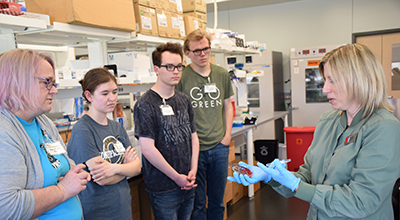In early 2022, three Lincoln Public Schools’ Science Focus students—Riley, Bailey, and Jacob—spent an afternoon each week in a University of Nebraska-Lincoln (UNL) microbiology lab, hunting bacteria. The LPS students weren’t out to destroy the organisms; they were trying to keep them alive.
These Lincoln high schoolers—and their teacher, Mark James—were guided by Paul Velander, assistant professor of Biochemistry at UNL, who led their learning of basic laboratory skills, then experimental design, and ultimately science communication as the high schoolers summarize their findings in posters sharing their research.
Their citizen science group is part of Tiny Earth: a project based at the University of Wisconsin-Madison, to help engage students in the sciences while “addressing one of the most pressing global health challenges of our century—the diminishing supply of effective antibiotics.” Tiny Earth participants take a research course aiming to discover antibiotics from soil bacteria in their own communities.
Rhonda Griess, UNL Biochemistry’s lab manager at the Beadle Center, provided lab space and support for this work. Also aiding the learning was UNL Biochemistry undergraduate Emily Kassing, who helped shape the students’ weekly gatherings as a peer educator, and wrote about the experience for her Honors Thesis.
Nebraska EPSCoR, funded by the National Science Foundation, sent its Outreach Coordinator – Dr. Jodi Sangster – to provide agar plates and other resources for these local students’ Tiny Earth work sessions. Sangster, whose Ph.D. is from UNL’s Civil Engineering program, leads the Young Nebraska Scientists’ (YNS) program via Nebraska EPSCoR, including mobile labs that provide sets of curriculum and supplies to requesting schools statewide.
“Tiny Earth is a global network of student scientists who collect local soils, extract bacteria, and identify potential antibiotic producers” Sangster said. “Information about these producers is loaded into a database which is shared with scientists who use the information to identify new antibiotic compounds. Our high school students were able to identify five colonies with pathogen-inhibiting properties. This is incredible, as these colonies can be exceedingly difficult to identify. This is a testament to the amount of time and energy Bailey, Jacob, and Riley invested in processing samples. The work they did as high school students may mean a new life-saving antibiotic will be available in the future.”
At the end of their project term, the LPS students and their UNL mentors visited the School of Veterinary Medicine and Biomedical Sciences’ new lab facilities at UNL’s East Campus. They enjoyed a site tour with lab manager Laura Leger while their collected bacterial samples were analyzed in minutes by MALDI-TOF: a laser-equipped machine that safely vaporizes a sample to identify it. One of the LPS students’ samples, collected from a trout stream in Wisconsin, was determined to be Staphylococcus aureus—a bacterium that generated a telltale “Zone of Inhibition” (production of a chemical that prevents or kills other bacteria surrounding it). The compositions of the samples from these LPS students’ efforts will be uploaded into the Tiny Earth database for further analysis and evaluation, helping to better understand our world.
Drs. Velander and Sangster agree on the enormous potential to adapt the Tiny Earth endeavor for a variety of educational purposes that will enrich high school science inquiry in the future. “Given UNL's tremendous teacher-lab resources, and ongoing support from the departments of Biochemistry and Microbiology, it is feasible that this work could be scaled up to develop formal course programming that would pair especially well with the recent early college career STEM program initiatives by UNL CASNR (College of Agricultural Sciences and Natural Resources) and Lincoln Northeast High School,” said Velander.
They also envision that the Tiny Earth program could be “adapted into one of Nebraska EPSCoR’s innovative YNS ‘mobile-lab’ platforms. Mobile labs are experiment-based modules that can be completed in a short amount of time, and provide a way to enrich the wet-lab capabilities of high school workspaces. “These pre-packaged and ready-to-use lab activities have been successfully deployed by high school teachers in the past—with folks like Dr. Sangster, and the infrastructure of EPSCoR, I think we could find creative ways to transform some aspects of the Tiny Earth programming into bite-size mobile lab experiences," Velander added. “This would expand and enrich the current set of mobile lab offerings by EPSCoR, which continue to augment both formal and informal high school STEM programming throughout the state of Nebraska.”
Meanwhile the initial LPS students—all three are seniors—look ahead to their own futures, and each agreed that this hands-on experience has helped boost their motivation to pursue careers in science. Bailey plans to study at Lincoln’s Bryan College of Health Sciences, specializing in orthopedics and nursing. Riley is interested in lab research work while attending college. Jacob considers adding a bioinformatics focus with his prior interest in computer science. And Emily, the undergraduate who had also served as a teaching assistant in UNL Biochemistry courses, graduates this spring with her bachelor’s degree and will work at a hospital for a year, prior to entering medical school.

Caption: Nebraska EPSCoR's Jodi Sangster (left) joins Lincoln Public Schools' Science Focus students in a visit to University of Nebraska-Lincoln's veterinary lab site, where Laura Leger (right) displays media for a sample to be analyzed.